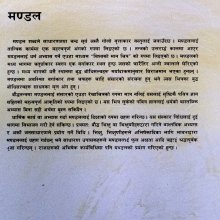Candrasurya, Candrasūrya, Candra-surya: 4 definitions
Introduction:
Candrasurya means something in Buddhism, Pali, Hinduism, Sanskrit. If you want to know the exact meaning, history, etymology or English translation of this term then check out the descriptions on this page. Add your comment or reference to a book if you want to contribute to this summary article.
Alternative spellings of this word include Chandrasurya.
Images (photo gallery)
In Hinduism
Shaktism (Shakta philosophy)
Source: Google Books: ManthanabhairavatantramCandrasūrya (चन्द्रसूर्य) refers to the “moon and the sun”, according to the Manthānabhairavatantra, a vast sprawling work that belongs to a corpus of Tantric texts concerned with the worship of the goddess Kubjikā.—Accordingly, “[...] (5) Above it (in the throat) is the Pure (Wheel) (viśuddhaka), which is said to be white, shining like heated mercury. There, in the middle, is the lord, a mass of energy, the Supreme Syllable. One should think that it shines like the Moon, Sun and Fire [i.e., candrasūrya-agni-saṃkāśa]. [...] (Perfect) contemplation (samādhi) is with (these) sixteen aspects and is (attained) within the form of the sixfold deposition (ṣoḍhānyāsa). He who knows this is (a veritable) Lord of Yogis, the others (who do not) are (just) quoting from books. Once attained the plane that is Void and Non-void, the yogi is freed from bondage”.

Shakta (शाक्त, śākta) or Shaktism (śāktism) represents a tradition of Hinduism where the Goddess (Devi) is revered and worshipped. Shakta literature includes a range of scriptures, including various Agamas and Tantras, although its roots may be traced back to the Vedas.
In Buddhism
Mahayana (major branch of Buddhism)
Source: academia.edu: A Study and Translation of the GaganagañjaparipṛcchāCandrasūrya (चन्द्रसूर्य) refers to the “sun and moon”, according to the Gaganagañjaparipṛcchā: the eighth chapter of the Mahāsaṃnipāta (a collection of Mahāyāna Buddhist Sūtras).—Accordingly, “Then the Lord smiled (smita), and the venerable Ānanda asked the meaning of smiling: ‘O Lord, as the Tathāgata does not smile for no reason, what is the reason for smiling?’ The Lord said: ‘[...] When this teaching was taught, the great rain of flowers, which have been never seen before, shining brilliantly like the radiant sun and moon (candrasūrya), poured down, and a voice resonated from those flowers: “Having heard this teaching of the Bodhisattva Gaganagñja, those living beings with faith, being sealed with the irreversible seal, will be devoted themselves to the place of awakening”.’ [...]”.

Mahayana (महायान, mahāyāna) is a major branch of Buddhism focusing on the path of a Bodhisattva (spiritual aspirants/ enlightened beings). Extant literature is vast and primarely composed in the Sanskrit language. There are many sūtras of which some of the earliest are the various Prajñāpāramitā sūtras.
Tibetan Buddhism (Vajrayana or tantric Buddhism)
Source: OSU Press: Cakrasamvara SamadhiCandrasūrya (चन्द्रसूर्य) refers to the “moon and sun”, according to the Cakrasaṃvara Samādhi [i.e., Cakrasamvara Meditation] ritual often performed in combination with the Cakrasaṃvara Samādhi, which refers to the primary pūjā and sādhanā practice of Newah Mahāyāna-Vajrayāna Buddhists in Nepal.—Accordingly, “Being in the heart with mud, a universal petaled lotus, Above the pericarp of the lotus, a moon and sun mandala (candrasūrya-maṇḍala), Above that, observe a Hūṃ, that changes into a two armed Saṃvara. Venerable, dark-blue color, one face, three eyes, standing in archer's pose. [...]”.

Tibetan Buddhism includes schools such as Nyingma, Kadampa, Kagyu and Gelug. Their primary canon of literature is divided in two broad categories: The Kangyur, which consists of Buddha’s words, and the Tengyur, which includes commentaries from various sources. Esotericism and tantra techniques (vajrayāna) are collected indepently.
Languages of India and abroad
Sanskrit dictionary
Source: Cologne Digital Sanskrit Dictionaries: Monier-Williams Sanskrit-English DictionaryCandrasūrya (चन्द्रसूर्य):—[=candra-sūrya] [from candra > cand] m. [dual number] moon and sun, [Horace H. Wilson]
Sanskrit, also spelled संस्कृतम् (saṃskṛtam), is an ancient language of India commonly seen as the grandmother of the Indo-European language family (even English!). Closely allied with Prakrit and Pali, Sanskrit is more exhaustive in both grammar and terms and has the most extensive collection of literature in the world, greatly surpassing its sister-languages Greek and Latin.
See also (Relevant definitions)
Partial matches: Surya, Candra.
Starts with: Candrasuryagraha, Candrasuryagrahodaharana, Candrasuryajihmikarana, Candrasuryajihmikaranaprabha, Candrasuryajihmikaraprabha, Candrasuryaksha, Candrasuryamandala, Candrasuryapradipa, Candrasuryatmaka, Candrasuryavimalaprabhasashri.
Full-text: Candrasuryapradipa, Candrasuryajihmikaranaprabha, Jihmikarana, Cubakali, Devakanta, Candrasuryaksha, Candrarkadipa, Jihmikara, Caturdashalokapala, Fourteen World Protectors, Prabha, Pradipa, Vikasin, Kanta.
Relevant text
Search found 11 books and stories containing Candrasurya, Candrasūrya, Candra-surya, Candra-sūrya; (plurals include: Candrasuryas, Candrasūryas, suryas, sūryas). You can also click to the full overview containing English textual excerpts. Below are direct links for the most relevant articles:
Chaitanya Bhagavata (by Bhumipati Dāsa)
Verse 2.14.48 < [Chapter 14 - Yamarāja’s Saṅkīrtana]
Verse 2.18.227 < [Chapter 18 - Mahāprabhu’s Dancing as a Gopī]
Verse 2.24.50 < [Chapter 24 - The Lord Displays His Universal Form to Advaita]
Cidgaganacandrika (study) (by S. Mahalakshmi)
Verse 7 [Rudra is Manthāna Bhairava] < [Chapter 1 - First Vimarśa]
Maha Prajnaparamita Sastra (by Gelongma Karma Migme Chödrön)
Act 9.8: Before departing, Samantaraśmi bows to the Buddhas of the East < [Chapter XV - The Arrival of the Bodhisattvas of the Ten Directions]
Emptiness 9: Absolute emptiness < [Chapter XLVIII - The Eighteen Emptinesses]
Historical Elements in the Matsya Purana (by Chaitali Kadia)
War and Weapons in the Matsya Purāṇa < [Chapter 5 - Cultural history in the Matsya-Purāṇa]
Puranic encyclopaedia (by Vettam Mani)
Mundaka Upanishad (Madhva commentary) (by Srisa Chandra Vasu)
